“I, Hemann Künig von Vach, with the help of God, wish to create a small book to be called Camino de Santiago. In it, I want to describe paths and trails and how each of the brothers of Santiago should procure food and drink, and I also want to mention the wrongdoings of the tavern keepers.”
The Guide of Hermann Künig
This is how the verse guide begins, written by the German monk of the Order of the Servants of Mary (known as the Servites) from the German town of Vacha, Hermann Künig, who wrote in German at the end of the 15th century, recounting his pilgrimage to Santiago de Compostela, with his journey to and from Germany. This journey, known as Vía Künig, was translated into a guide first published in Leipzig in 1495, which became a great success as it was published four more times during the early days of the printing press.
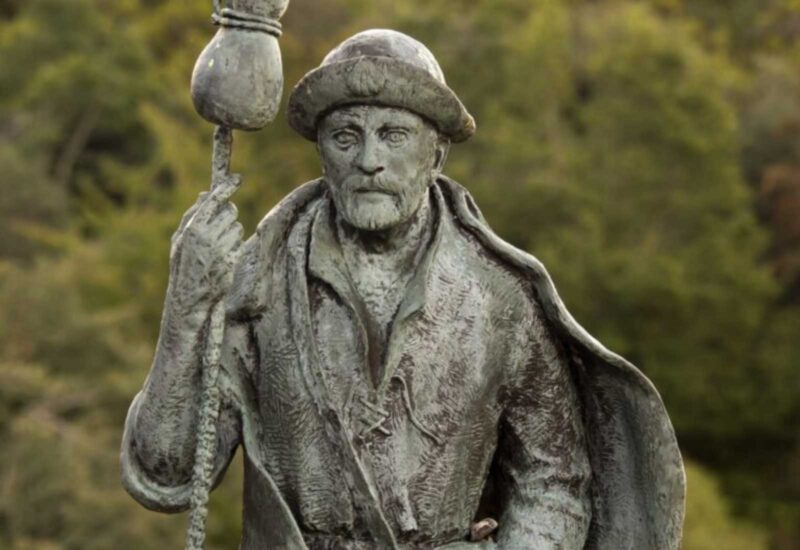
Statue of Hermann Künig
We don’t know if good old Hermann read the Codex Calixtinus, another one of the famous books of the Camino de Santiago. He probably did, but his intention was the same as that of the monk Aymeric Picaud with his 12th-century text, that is, to provide information about the Camino to the pilgrim, especially for his fellow countrymen, although with a significant difference compared to the Codex Calixtinus: Hermann reached Santiago de Compostela by the Camino Francés, but taking a different route between San Martín del Camino and Ponferrada, and then another different section reaching Lugo, thus creating the Vía Künig. Route indications, many hospitals, and numerous churches are listed in the guide. What stands out the most are the warnings Hermann gives about the places and people that his fellow countrymen will encounter on the way.
“I, Hermann Kunig, […] have written this little book called Camino de Santiago. May God allow me never to die, if I cannot be forever with him.”
Let’s learn more about this route that offers an alternative path in the Montes de León and at the border between León and Galicia, avoiding steep ascents to Foncebadón, O Cebreiro, and Alto do Poio, especially in winter when the snow makes passage difficult.
The Vía: 199 km in 9 stages
With a total of 199 km between San Martín del Camino and Lugo, the stages could be divided as follows:
- San Martín del Camino – Porqueros / 25 km (province of León)
- Porqueros – Torre del Bierzo / 21 km (province of León)
- Torre del Bierzo – Ponferrada / 26 km (province of León)
- Ponferrada – Villafranca del Bierzo / 24 km (province of León, corresponds with the Camino Francés)
- Villafranca del Bierzo – Pedrafita do Cebreiro / 24 km (provinces of León and Lugo)
- Pedrafita do Cebreiro – As Nogais / 14 km (province of Lugo)
- As Nogais – Baralla / 25 km (province of Lugo)
- Baralla – O Corgo / 21 km (province of Lugo)
- O Corgo – Lugo / 19 km (province of Lugo)
From Lugo, the Vía Künig continues along the Camino Primitivo and in Melide connects with the Camino Francés to Santiago de Compostela.
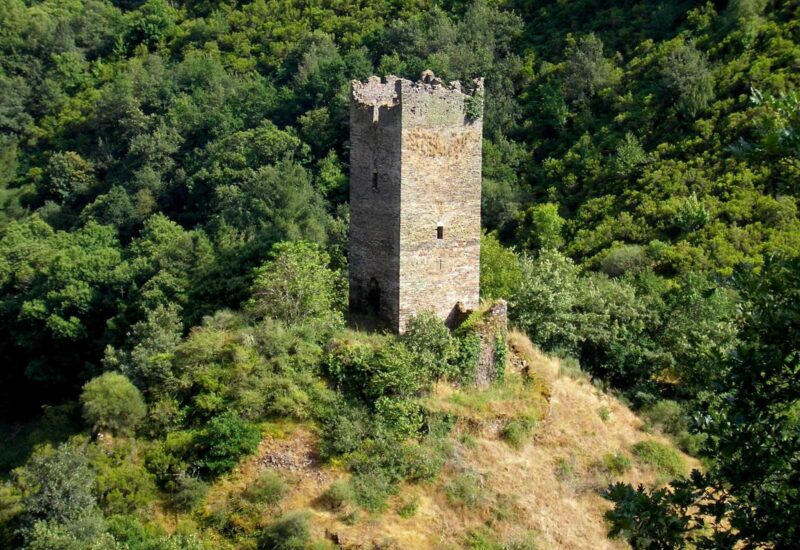
Castle in the Vía Künig
The Vía Künig in the Montes de León
Halfway between León and Astorga is the town of San Martín del Camino, where to the left you reach Astorga, which Hermann advises against. In his words, “If you follow my advice, turn right here and you won’t have to climb the mountains. All of them are to the left. My advice is to avoid Rabanal”. Thus, in San Martín del Camino, Hermann decides to diverge from the Camino Francés heading northwest to reach Ponferrada and the Bierzo without passing through Astorga or ascending Foncebadón (Rabanal del Camino).
This alternative passes through the towns of Santa Marina del Rey, Benavides, Cogorderos, Zacos, Porqueros, Valbuena de la Encomienda, Villagatón, Brañuelas, Cerezal del Tremor, Torre del Bierzo, Bembibre, and finally Ponferrada. The landscapes, with terrain much friendlier than the Camino Francés through these lands, are those of valleys bathed by the rivers Órbigo, Tuerto, and Porcos.
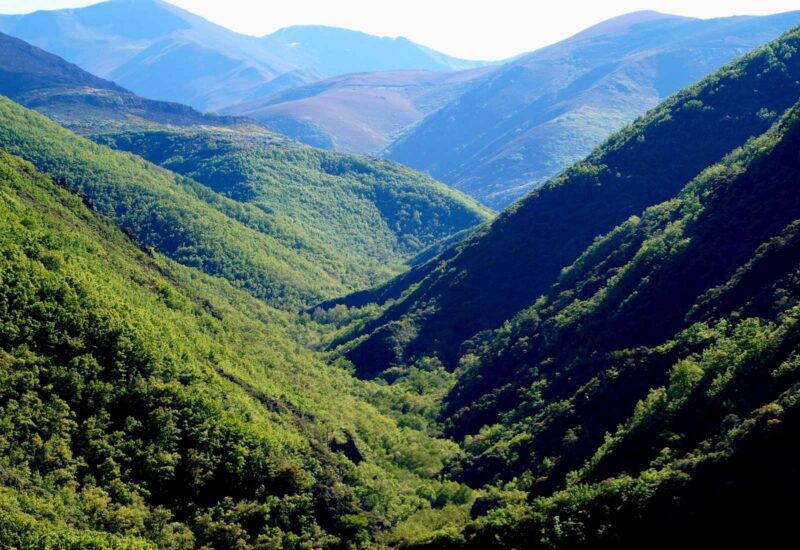
The mountains of León in the Vía Künig
The Vía Künig in Galicia, signposted
We leave Castilla y León leaving behind Ponferrada, Cacabelos, and Villafranca del Bierzo. We also pass through Pereje, Trabadelo, and Portela de Valcarce to reach Herrerías, at the gates of Galicia. Once in Galicia, in Pedrafita de O Cebreiro, the Vía Künig heads toward Lugo, passing through As Nogais, Becerreá, Baralla, O Corgo and finally Lugo. Thus, it aims to avoid the mountains of O Cebreiro and the climb to Alto do Poio in Padornelo.
Herrerías – Pedrafita de O Cebreiro (9 km)
In Herrerías we are still following the Camino Francés, but after passing Hospital and crossing its second bridge over the river das Lamas, we diverge to the right, parallel to the river. We gently ascend for a little over 1.5 km to the village of San Tirso. Upon arrival, we turn left, leaving the church behind, and then turn right before a white house. We continue and leave an old oven and a laundry on the left. We descend and cross a stream via a wooden bridge, then ascend to the N-VI road, which is not very busy as it is old. We will reach the village of El Castro via the road and then take a track that allows us to pass under the A-6 highway to access this place. Once here, we will continue straight along the road until we reach Pedrafita de O Cebreiro, where a statue of Künig awaits us. There are services only in Herrerías and Pedrafita de O Cebreiro on this stage.
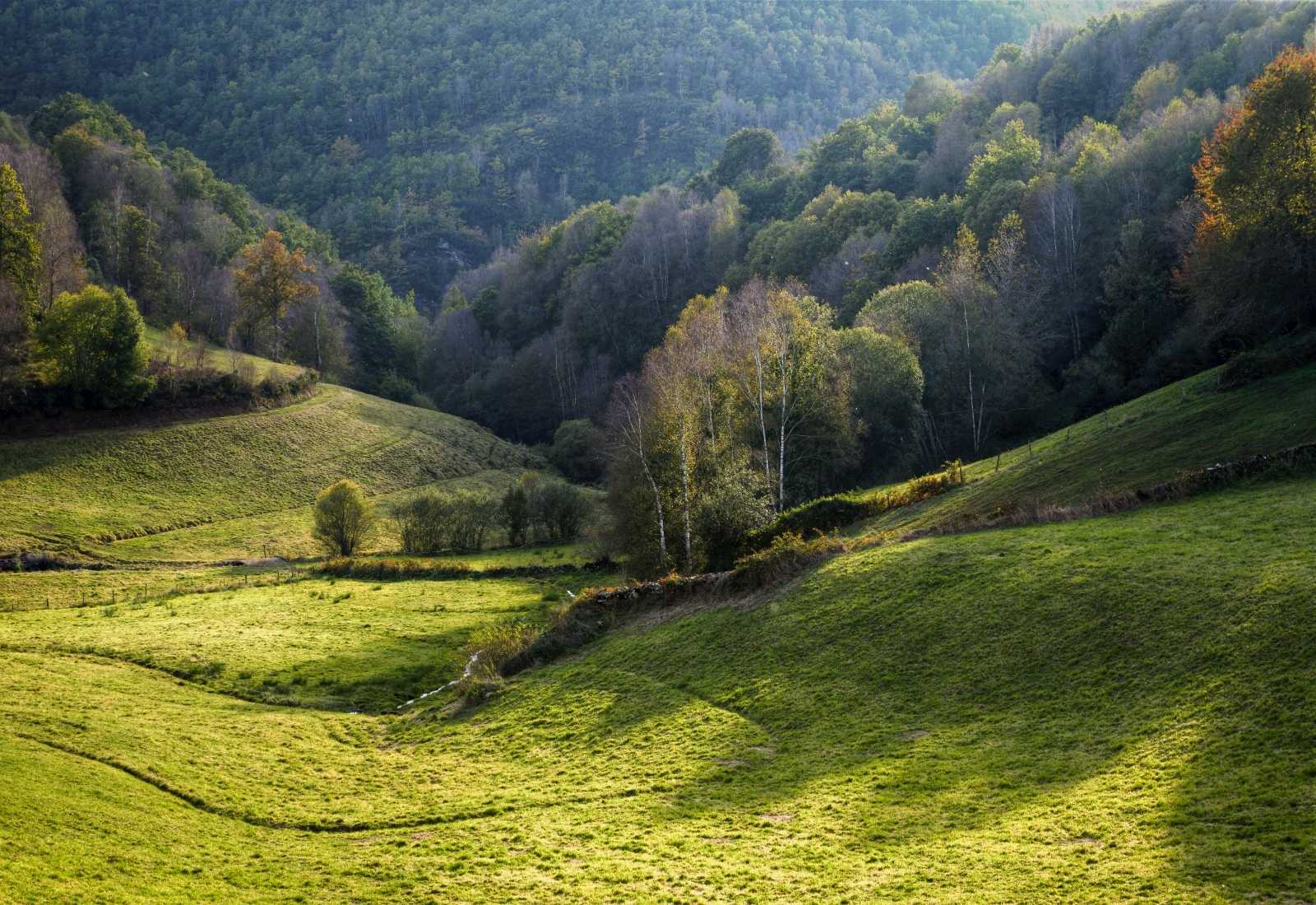
Landscape of the Ancares
Pedrafita de O Cebreiro – As Nogais (14 km)
We leave Pedrafita de O Cebreiro, which has all services, to reach As Nogais always via a wide dirt track and gravel; a true luxury, as it will be 14 km of the ancient Camino Real built by Carlos III in the 18th century.
Leaving the town’s school on the right we will already find the Vía Künig signage. On this stage we will reach 1,200 meters above sea level at Alto del Carballón, progressively descending thereafter. In A Serra, we will find more information panels, and then we will pass through Castelo and Doncos, and shortly after the road will lead us to As Nogais, which has several services.
As Nogais – Baralla (25 km)
We leave As Nogais and face a stage with much asphalt, though with no great danger, as it is the old national road, not very busy. We pass through Ferrería and cross the Navia River. We pass Agüieira, Os Grobos, and Mesón Vello. Shortly after, we reach the Chapel of San Benito de Horta and later Cruzul, with its 18th-century bridge over the Narón River. We continue and shortly after leave a industrial park on the right, which signals the arrival at Becerreá, where you have services.
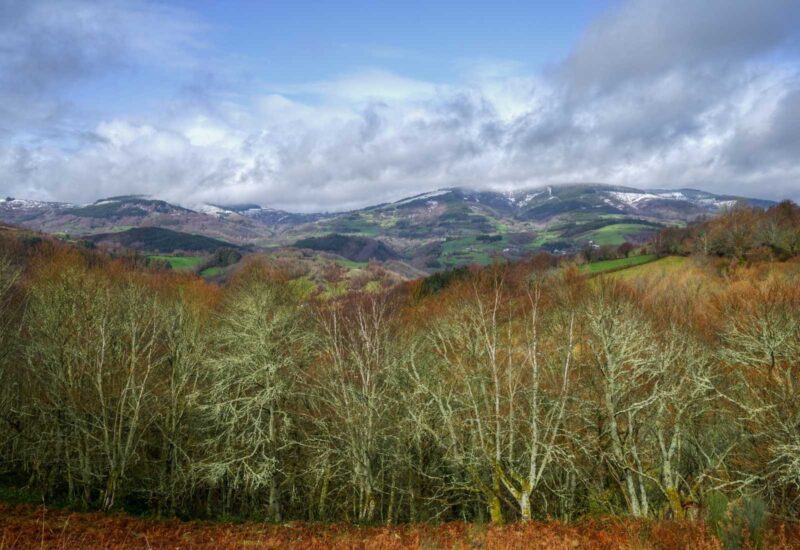
Vía Künig at its passage through As Nogais
We continue leaving Becerreá and pass through the church of San Pedro de Cadoalla, 18th century, as well as its fountain, a little further. Then, we reach Cereixal, with its church of San José. We continue and arrive at the O Forno de Cal fountain, where we will find a couple of restaurants. This will be the highest point of this stage, at 800 meters above sea level. We pass Campo da Árbore and the road leads us to Constantín and its chapel of Santa María, which announces our arrival in Baralla, with all services.
Baralla – O Corgo (21 km)
We leave Baralla to face a stage with asphalt, dirt tracks, and trails. We pass through Ferreiros and its laundry to reach Vilartelín, with its church of Santa Eufemia. We pass through Vilanova and Santa Cruz, with its Chapel of Los Remedios. We continue over the A-6 highway via a viaduct and arrive at Sobrado de Picato, with its church and services such as a couple of bars and a gas station, as we are on the N-VI road. We keep walking and pass a tunnel under the A-6 that takes us to Ermida and Outeiro, to cross the highway again under a tunnel. We cross the bridge over the Toldea River and admire its old mill, and shortly after, we arrive at Castrillón and its Chapel of San Salvador and Sanctuary of San Bernabé. We advance and cross another tunnel over the A-6 highway to finally arrive at O Corgo, with all services.
O Corgo – Lugo (19 km)
We leave O Corgo by its health center and cross the A-6 highway under a viaduct that takes us to Lamas and Pedrafita, with its church of San Miguel. Heading northwest, we cross the Galiñeiros bridge over the Chamoso River and reach Arxemil, with its church of San Pedro. Leaving this village we will find a Roman milestone of the Via XIX, which, coming from Braga, connected this city with Lugo to reach Astorga. Shortly after, we arrive at Quintela and Coeo, with their church of San Vicente. We will find another milestone of the Via XIX and pass a tunnel under the A-6 highway that takes us to San Mamede de los Ángeles and its church. We arrive at San Andrés do Castro and its church, and shortly after to the convent of San Antón and its tower of San Amaro. Here, we can deviate to the N-VI road if we need any services, as there are bars and restaurants.
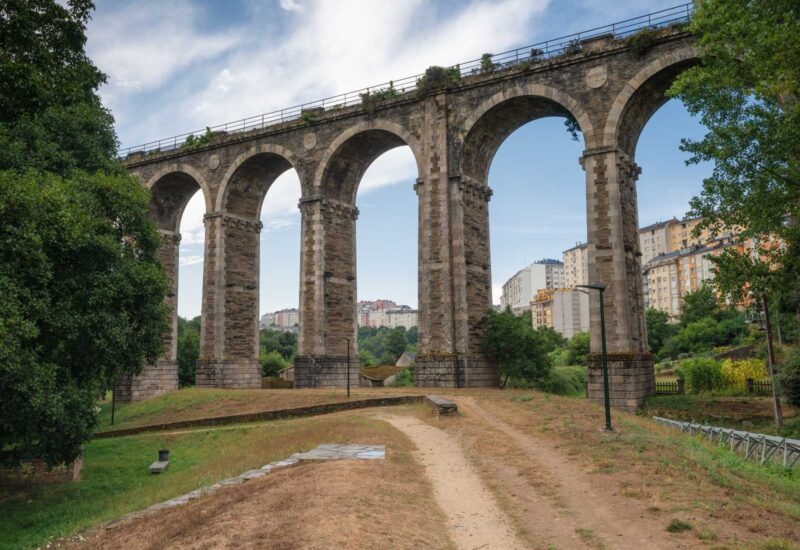
Paseo do Rato, parallel to the Rio Chanca in the Vía Künig as it passes through Lugo
At the gates of Lugo, the Paseo do Rato takes us north, parallel to the Rio da Chanca, an area that also has some restaurants. We cross a bridge and are already on the outskirts of Lugo. We proceed towards the Ronda das Fontiñas, then by the Calle San Xillao and access Catasol street, which leads us to the chapel of San Roque and the street of the same name. Suddenly, we find one of the gates of the Lugo wall, and we can now say that we have reached the Camino Primitivo. We cross the wall and shortly after arrive at the public pilgrim albergue in Lugo.
An Alternative Legendary Pilgrimage
“The city is built in an uncommon way, something everyone sees with pleasure”, said Künig about the city of Lugo.
The Vía, still not officialized at the Santiago Compostela Pilgrim’s Office, is being studied by the involved municipalities, and together with the Xunta de Galicia, it has been signposted in recent years, as well as opening historical sections and working on maintaining the paths.
We encourage you to get to know it, as it will be an original and alternative adventure, and as always we are at your disposal to organize your adventure. ¡Ultreia!

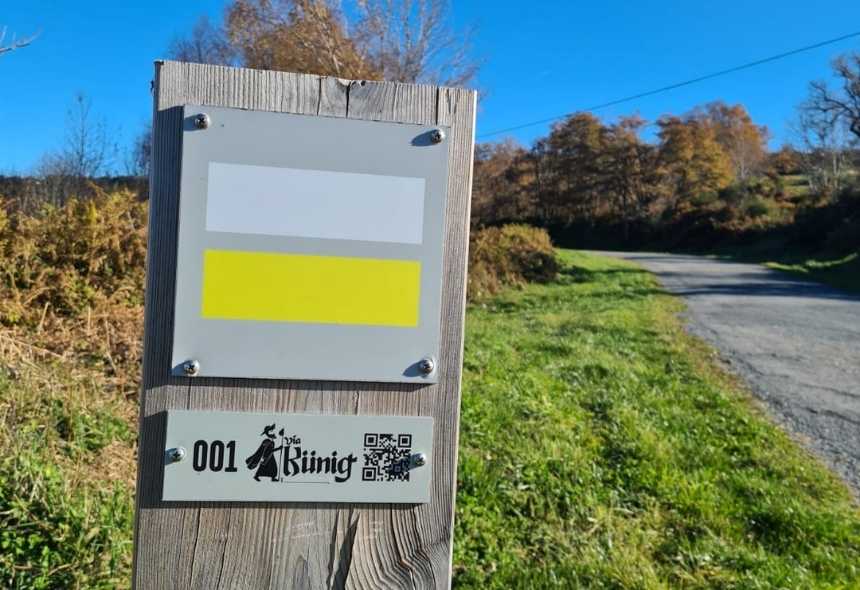










Leave A Comment